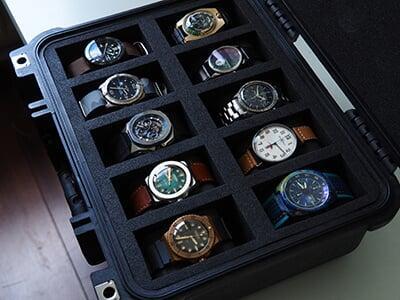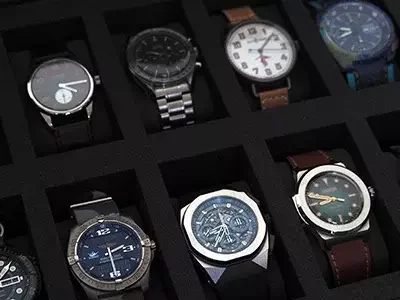In this post, Rob Nudds, Managing Editor for FratelloWatches, explains why he is an avid fan of Peli cases for the transport and storage of his watch collection.
If you’ve ever read any of my watch reviews, tuned in to any of my Podcasts, or accidentally stumbled into an Instagram Live session, while I happen to be polluting the internet with my face, chances are you’ve seen or heard me wax lyrical about the virtues of Peli cases as a method of luxury watch storage.
I’ve been banging this drum for years. Back when I was a watchmaker, I became obsessed with the Peli brand. I used to carry my tools in Pick N Pluck foam cases I bought from the store. I doubted then that anyone had thought of using these ultra-resistant cases for the same purpose, but in the years since I’ve met several watch collectors that share my passion.

And why not? Even the tools we use in watchmaking are high-value and occasionally delicate. Having adequate protection for your investments — whatever form they take — is never a bad idea. Using cases that are, in themselves, well-designed and well-engineered makes sense. More than that, I feel my watches deserve something about which I am equally enthusiastic. I could talk at length about the practical virtues of the cases, but for me it’s always gone beyond that. It’s about extending and enhancing the ownership experience. I get just as much joy from viewing or transporting my collection (or parts of it, at least) in cases that are as collectible as many of the pieces within.
Currently, I use four different types of Peli cases for storing and transporting my watches and the associated tools of my trade. Now, as a journalist primarily, my toolkit has been replaced by photographic equipment. My choice for carrying this gear with me when flying is the carry-on size 1535 Peli Air, which has a Hybrid case interior with a Pick N Pluck foam area as well as a separate TrekPak compartment for storing other items (for one night stays I actually use this for a couple of t-shirts, socks, and underwear). I keep a very small, emergency tool kit (and some spare straps) in a tiny Peli Ruck Case, which can normally be found kicking around in the bottom of a backpack.
My stay-at-home collection can be found in a Peli 1500, which was converted for watch storage by a German company known as “Black Steel Watches”. It holds fifteen units and is a dream to use, with the foam expertly cut to accommodate watches up to at least 56mm in diameter (that’s the largest one I have in my collection — a Casio Mudmaster for the curious among you).
But the case I use more than any other is a 10-watch set-up purchased from The Case Farm. The case began life as a basic Peli 1400. The inserts cut for watches are generously sized and versatile, but are not as sculpted, nor as secure as the ones from Black Steel. The advantage of the 1400 (and The Case Farm in general) is that its cases are readily available and reasonably priced.

As far as a decent return on your investment goes, you can’t go far wrong with the Peli Cases supplied with custom foam from The Case Farm, but if you don’t like the look of the layout you could go direct and customize the foam yourself to fit your needs with Peli's standard Pick N Pluck foam. That’s what I did with the Peli Air and, I have to say, it worked out rather well.
For the perfectionists out there, Peli also offers custom case and custom foam solutions that will perfectly fit whatever it is you are using a Peli case for.
When it comes to durability and security, I couldn’t ask for more from this gear. I’ll be testing all of these products more extensively in the future so check back for more detailed reviews on each and every one of them.
Find out more about Peli's line of protective cases by clicking on the button below.
3. VERSATILITY: MODES/BRIGHTNESS SETTINGS
The tactical flashlight should have a momentary-on option and a constant-on option. Momentary-on means that the user should be able to depress the button slightly to turn it on, but then let go to turn it off. The constant-on option, as you might imagine, is when the tail cap switch is depressed completely until there is a click and it stays on once released. It should have both of these.
It should also have various brightness settings. Usually there will be three brightness settings: low, medium and high. In addition, there is often an option for a strobe or staggered pulse light setting included.
The strobe is another setting that can be used to disorient an assailant. The rapid on and off of the light causes a person or object on the move to appear in and out of sync and it can take the brain a while to adjust to that. This is also known as the Bucha effect or flicker vertigo. Thus, this gives the light user time to take an action and subdue the assailant. In any case, all these settings should be able to be easily cycled through by tapping the tail cap button continuously.
4. Reliability: Long run-time and rechargeable batteries
You can edit text on your website by double clicking on a text box on your website. Alternatively, when you select a text box a settings menu will appear. your website by double clicking on a text box on your website. Alternatively, when you select a text box
5. Robust & Durable: Hard Casing, Waterproof & Shockproof
A tactical flashlight should be robust and durable. As was mentioned quite a few times previously, these flashlights are designed for professional use and thus must be able to stand up to the rigors of harsh conditions in the field. These flashlights can take a beating, whether it be from inclement weather or just general everyday use on the job. Thus, they should be both waterproof and shockproof.
As was stated earlier in this piece, tactical flashlights used to be designated essentially as a secondary mode of protection for law enforcement officers. Although the tactical flashlights are generally smaller these days, they must still be able to be used for self-defense should the situation arise. Thus, these flashlights usually have an end that is harder and normally has a distinctive serrated edge that is ideal for striking and doing some damage in the process. Not that we advocate for violence here at Peli, but it’s just a reality of the job that professionals in law enforcement, military and security undertake on a daily basis. Sometimes threats need to be neutralized by any means necessary. And tactical torches are ideal for those situations.
CONCLUSION: TACTICAL LIGHTS ARE NOT YOUR RUN-OF-THE-MILL TORCH
So, after all that has been said, it’s probably safe to say that you now have a better understanding of what exactly a tactical flashlight is. Additionally, it’s pretty obvious that a tactical flashlight is not your run-of-the-mill flashlight. Nevertheless, these flashlights are of the highest quality, and although they are designed for professional use, they are also ideal for the everyday carry or to keep around the house.
We’ll get into the various uses of these tactical flashlights in a future post in this series on tactical lights. In the meantime, if you’re interested in seeing our full catalogue of Peli Tactical Torches, have a look here.
Rob Nudds is an avid wrist watch collector, watchmaker, and currently the Managing Editor for FratelloWatches, a website that produces content about new watches and vintage watches, the watch industry, useful information for watch collectors, and just about anything else you can think of related to watches.
Follow Rob on Instagram and check out FratelloWatches.

